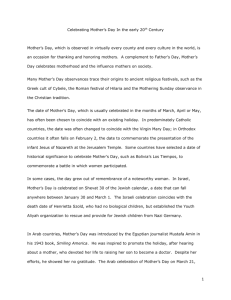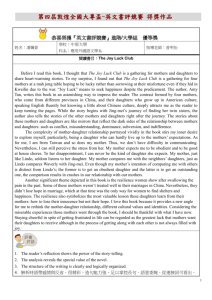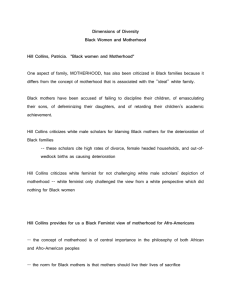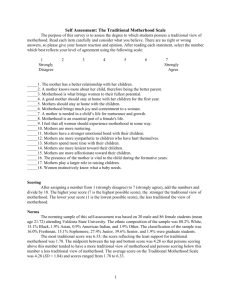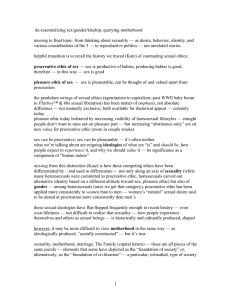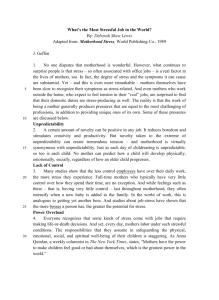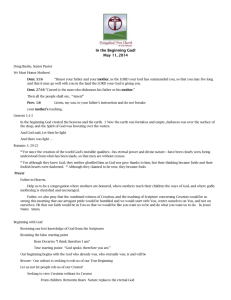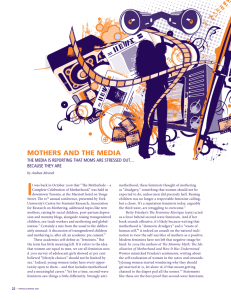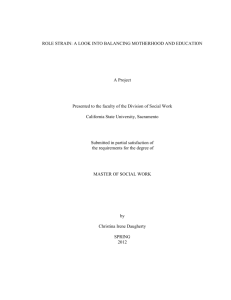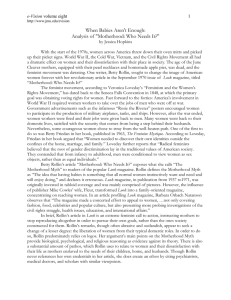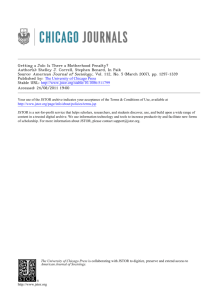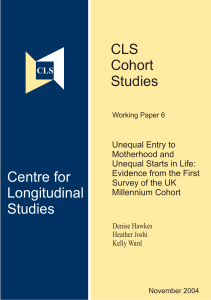“Motherhood and Daughterhood” by Adrienne Rich
advertisement
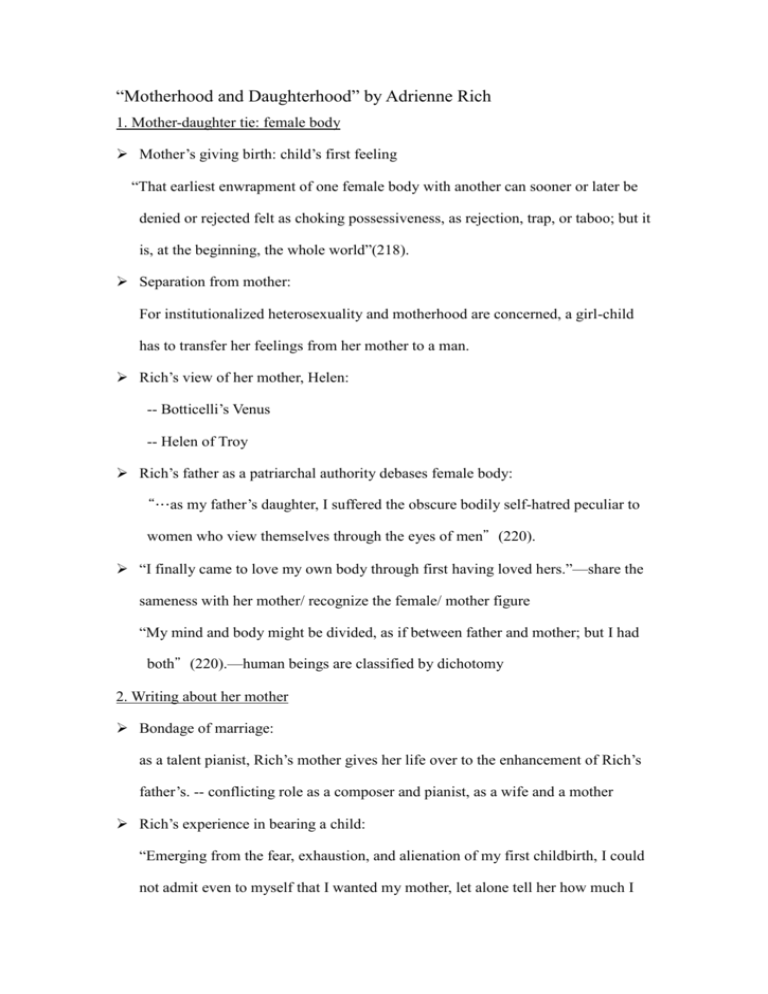
“Motherhood and Daughterhood” by Adrienne Rich 1. Mother-daughter tie: female body Mother’s giving birth: child’s first feeling “That earliest enwrapment of one female body with another can sooner or later be denied or rejected felt as choking possessiveness, as rejection, trap, or taboo; but it is, at the beginning, the whole world”(218). Separation from mother: For institutionalized heterosexuality and motherhood are concerned, a girl-child has to transfer her feelings from her mother to a man. Rich’s view of her mother, Helen: -- Botticelli’s Venus -- Helen of Troy Rich’s father as a patriarchal authority debases female body: “…as my father’s daughter, I suffered the obscure bodily self-hatred peculiar to women who view themselves through the eyes of men”(220). “I finally came to love my own body through first having loved hers.”—share the sameness with her mother/ recognize the female/ mother figure “My mind and body might be divided, as if between father and mother; but I had both”(220).—human beings are classified by dichotomy 2. Writing about her mother Bondage of marriage: as a talent pianist, Rich’s mother gives her life over to the enhancement of Rich’s father’s. -- conflicting role as a composer and pianist, as a wife and a mother Rich’s experience in bearing a child: “Emerging from the fear, exhaustion, and alienation of my first childbirth, I could not admit even to myself that I wanted my mother, let alone tell her how much I Chen 2 wanted her”(222). “I wanted her to mother me again”(223).– share the same feeling as a mother Maternal guilt: “Am I doing what is right? Am I doing enough? Am I doing too much?”(223)– all mothers’ guilt of failing their children is internalized by the institution of motherhood. Mother as a contradictory role in the institutionalized motherhood: Owing to patriarchal perspective, a woman has to confront the requirements of being a “good mother”identified by social norms. 3. The cathexis between mother and daughter Mother and son appear as the eternal, determinative dyad. Sons imitating the image of father can be seen as the father’s second birth and also the producer of theology, art and social theory. The close relationship between mother and daughter is a threat to men: “Daughters have been nullified by silence, but also by infanticide, of which they have everywhere been the primary victims”(226). Virginia Woolf’s To the Lighthouse -- Mrs. Ramsay– mother is a central figure who spends all her life to satisfy male needs. (idealization) “she needs men as much as they need her, her power and strength are founded on the dependency, the ‘sterility’ of others” (228). -- Lily Briscoe– a daughter figure who does not seemingly become one with Mrs. Ramsay but can transcend the mother-son (Mrs. Ramsay and James) dyad and be independent of men through her artistic creation. -- To the Lighthouse as a projection of Woolf’s relationship with her mother: identified herself to be Lily Briscoe, she seeks intimacy with her mother and with another woman. (activist vs. conservative) Chen 3 Emily Dickinson, and Sylvia Plath: as artists, they lead a different life from conventional women or their mothers and do not live up to their mothers’ expectation. Radclyffe Hall’s The Well of Loneliness: a lesbian fiction about a gape between a mother and her lesbian daughter -- the relationship between a woman and her female lover, between her own mother and her and her son and her shows the motherbond in a “female world”. -- daughters were born into a female world: Rosenberg finds that “an intimate mother-daughter relationship … at the heart of this female world” suggests “an apprenticeship system … mothers and other older women carefully trained daughters in the arts of housewifery and motherhood” (233).—female ancestors are the central in the house: Housekeeping The loneliness and nostalgia of immigrant women: the frontier offers the chance to break out of traditional roles, but it tears them from their mothers. 4. “Matrophobia” Lynn Sukenick takes it as the fear not of one’s mother or of motherhood but of becoming one’s mother. -- daughters’ ambivalent attitudes toward their mothers -- “Jewish mother”: stands for the victim in the role of full-time mother-housewife, the martyr of conventional motherhood. -- matrophobia, a self-separation from the bondage imposing on mothers and a search for individual desire and freedom. 5. The reunion of mother and daughter: the mother-daughter myth of Demeter and Kore Return to her mother: the queen of the dead, Persephone (Kore), with her son back to her mother, Demeter, shows the reintegration of death and birth against the Chen 4 patriarchal splitting that may sever them. A new vision of the myth: shows the multiple perspectives on the Great Goddess in the classical-patriarchal world—mother’s power can transgress the boundaries of life and death and get the reconciliation with her lost self. Modern view on the Demeter- Kore myth: a representation in Margaret Atwood’s Surfacing. 7. A mother’s victimization in patriarchy In the patriarchal society, the worth of a mother or the expectation for the female is determined by social consensus. Women’s conformity to a degrading role is regarded to be a survival for both mothers and daughters. -- Mrs. Ramsay’s mothering men makes her feel stronger. She needs the neediness of others in order to feel her own strength. Mothers’ own guilt and self-hatred affect their daughters’ experiences: a daughter’s “penis envy”in Freudian psychoanalysis is to show a daughter’s rage at her mother’s powerlessness or lack of struggle from patriarchy. 8. A new version of “mother love” Go against the old, institutionalized and sacrificial motherhood identified by men. Inspire and expand female capability between two mothers: 1. the biological one, who stands for the ideology of domesticity, of conventional expectations 2. an artist or teacher, the “counter-mother,”who presents the strength in her body and leads a free life in the world -- the different types of mother offer the woman a chance to alternately live as one or the other “mother” and give them multiple identifications. 9. Against polarization: women are heterogeneous existences Women are divided into “mothers”and “nonmothers”– judge a woman by Chen 5 childbearing and childlessness. Women are narrowed down by some stereotypes or general classification: The Virgin Mother “The ‘childless woman’ and the ‘mother’ are a false polarity, which has served the institutions both of motherhood and heterosexuality”(250).– the images of woman and mother constructed by social institutions in order to conform to the thinking of motherhood and heterosexuality are distorted. Women cannot simply categorized by dichotomy, the either/or way. (“either” mothers “or”daughters/ mothering or nonmothering) Women have various images in their choices. 10. Reintegration with mothers through writing Adrienne Rich through writing her mother reconsiders the relationship between her mother and her. Rich’s conclusion: “Women are made taboo to women—not just sexually, but as comrades, cocreators, coinspiritors. In breaking this taboo, we are reuniting with our mothers; in reuniting with our mothers, we are breaking this taboo”(255).
